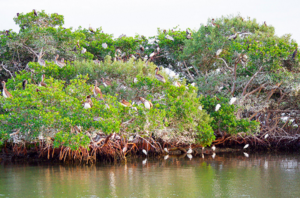
 EU passes law to restore 20% of bloc’s land and sea by end of decade, theguardian.com (Jun 17, 2024)
EU passes law to restore 20% of bloc’s land and sea by end of decade, theguardian.com (Jun 17, 2024)  Wild horses return to Kazakhstan steppes after absence of two centuries, theguardian.com (Jun 10, 2024)
Wild horses return to Kazakhstan steppes after absence of two centuries, theguardian.com (Jun 10, 2024)  Herd of 170 bison could help store CO2 equivalent of almost 2m cars, researchers say, theguardian.com (May 15, 2024)
Herd of 170 bison could help store CO2 equivalent of almost 2m cars, researchers say, theguardian.com (May 15, 2024)
Community action projects[edit | edit source]
- Rewilding projects which have community involvement.
- Sea rewilding
Events[edit | edit source]
 Mar 20, 2024 (Wed) — World Rewilding Day
Mar 20, 2024 (Wed) — World Rewilding Day Jun 05, 2024 (Wed) — World Environment Day
Jun 05, 2024 (Wed) — World Environment Day Mar 01, 2025 (Sat) — World Seagrass Day, Mar 1, annually. Raising awareness about seagrass and its important functions in the marine ecosystem.
Mar 01, 2025 (Sat) — World Seagrass Day, Mar 1, annually. Raising awareness about seagrass and its important functions in the marine ecosystem.
Networks[edit | edit source]
- Rewilding Global, Alliance for a Wilder Earth, "Millions of people are rewilding Earth to help nature heal. You can help." added 10:56, 7 December 2021 (UTC)
Organisations working with communities[edit | edit source]
- Re:wild, Guardians of the Earth, rewild.org, Newsroom, rewild.org, added 12:56, 21 June 2023 (UTC)
Maps[edit | edit source]
- Global Rewilding Alliance, explorer.land
Sea rewilding[edit | edit source]
Sea rewilding (also known as marine rewilding) is an area of environmental conservation activity which focuses on rewilding, restoring ocean life and returning seas to a more natural state. Sea rewilding projects operate around the world, working to repopulate a wide range of organisms, including giant clams, sharks, skates, sea sturgeons, and many other species. Rewilding marine and coastal ecosystems offer potential ways to mitigate climate change and sequester carbon. Sea rewilding projects are currently less common than those focusing on rewilding land, and seas are under increasing stress from the blue economy – commercial activities which further stress the marine environment. Rewilding projects held near coastal communities can economically benefit local businesses as well as individuals and communities a whole.
Climate change mitigation effects of rewilding[edit | edit source]
Conserving areas by protecting areas can boost the carbon sequestration capacity. The European Union, through the EU Biodiversity Strategy for 2030 targets to protect 30% of the sea territory and 30% of the land territory by 2030. In 2021, 7 countries (the G7) pledged to protect or preserve at least 30% of the world's land and 30% of the world's oceans to halt biodiversity loss. A survey by the United Nations Development Programme of public opinion on climate change found that forests and land conservation policies were the most popular solutions of climate change mitigation. W
About Rewilding[edit | edit source]
Rewilding is a form of ecological restoration aimed at increasing biodiversity and restoring natural processes. It differs from other forms of ecological restoration in that rewilding aspires to reduce human influence on ecosystems. It is also distinct from other forms of restoration in that, while it places emphasis on recovering geographically specific sets of ecological interactions and functions that would have maintained ecosystems prior to human influence, rewilding is open to novel or emerging ecosystems which encompass new species and new interactions.
A key feature of rewilding is its focus on replacing human interventions with natural processes. Rewilding enables the return of intact large mammal assemblages. This implies the natural groupings of large mammal species in an area to promote the restoration of trophic networks. The mechanism of rewilding is a process of rebuilding, to restore natural ecosystems by introducing or re-introducing large mammals to promote resilient, self-regulating, and self-sustaining ecosystems. Rewilding projects are usually part of programs for habitat restoration and conservation biology, and ideally they should be based on sound ecological theory and evidence.
While rewilding initiatives can be controversial, the United Nations has listed rewilding as one of several methods needed to achieve massive scale restoration of natural ecosystems, which they say must be accomplished by 2030 as part of the 30x30 campaign.
Both grassroots groups and major international conservation organizations have incorporated rewilding into projects to protect and restore large-scale core wilderness areas, corridors (or connectivity) between them, and apex predators, carnivores, or keystone species (species which interact strongly with the environment, such as elephant and beaver).

